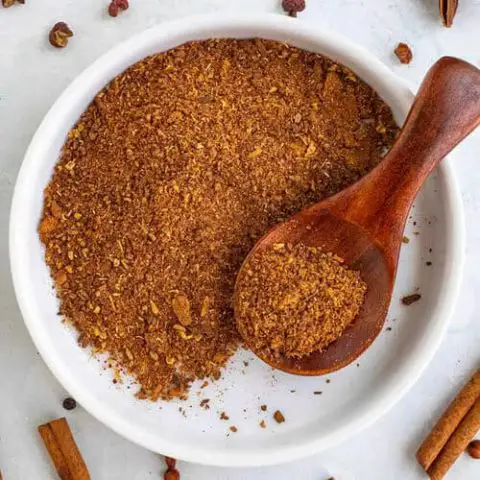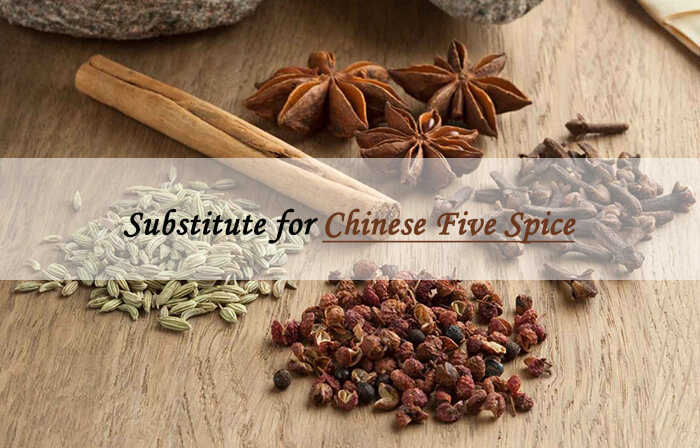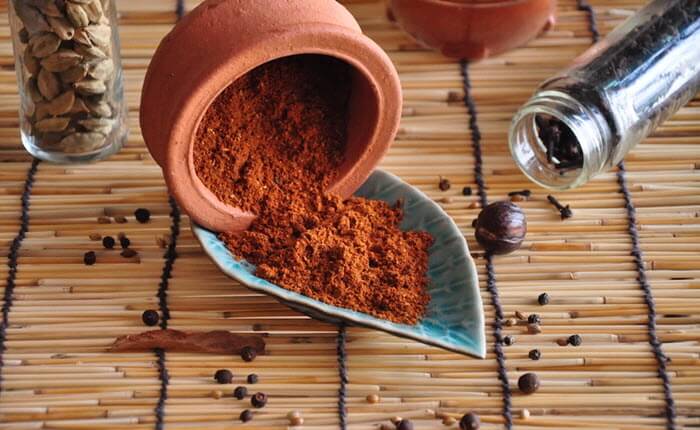Chinese Five Spice, which has been used in Chinese cuisine for generations, is definitely something you’ve heard of. Despite being well-known, its beginnings are still somewhat a mystery.
We are aware that the origins of this spice appear to be in traditional Chinese medicine. By combining the five basic tastes used historically in Chinese and Southeast Asian cuisine—sweet, sour, acidic, bitter, and salty—the concoction was thought to promote interior harmony.
What can you use to substitute for Chinese Five Spice when it’s run out of?
Read on to find the answer.
Table Of Contents
What is Chinese Five Spice?
Depending on the brand, the moniker “Chinese Five Spice” may be somewhat of a misnomer.
Cinnamon, fennel, cloves, Sichuan peppercorns, and star anise are the most typical ingredients in Chinese Five Spice blends. Other components like licorice, orange peel, galangal, and fresh ginger may also be used in many recipes.
Regardless of how many spices it contains, it has a strong scent and flavor.
The star anise of Chinese Five Spice has a little licorice flavor, while the cinnamon and fennel have warm, sweet undertones. The cloves are robust, sweet, and somewhat bitter, whilst the Sichuan peppercorns have a flowery, almost lemony flavor.
All of these tastes, combined in their varied ratios, provide a distinctive spice combination that you really have to taste to appreciate.
What Can You Substitute for Chinese Five Spice?
If Chinese Five Spice doesn’t suit your tastes, you’re in luck! There are a ton of great alternatives out there, including:
1. Garam Masala
A mixture of ground spices known as garam masala is a mainstay of Indian cooking.
Despite the fact that the components of Garam Masala vary by area, they frequently contain cumin, cardamom, cinnamon, clove, black pepper, coriander, and nutmeg. Other varieties could include components like ginger, saffron, mace, bay leaves, and fennel seeds.
Garam Masala enhances the flavor of any food by adding a warm, sweet, and mildly spiciness. As a result, it’s popular when you run out of Chinese Five Spice or don’t like it.
Make careful to start with tiny quantities and add more if you want to if you decide to give it a try.
2. Za’atar
Another spice and herb mixture that is well-known for its lemony and nutty flavor is za’atar.
Despite the fact that regional variations exist in Za’atar recipes, sumac, oregano, sesame seeds, salt, and thyme are among its most often used components.
Za’atar can be used in dips, soups, sauces, marinades, vegetables, grains, meat, and other dishes.
The addition of Za’atar as one of the components in certain five-spice variations is what makes it so intriguing. So it comes as no surprise that Za’atar is one of the most often used alternatives to Chinese Five Spice.
However, you should only use a small amount of this mixture because of how flavorful it is.
3. Star Anise
The flavor of star anise, a well-liked spice, is hot, sweet, and peppery.
In actuality, licorice, fennel seeds, and cloves taste like star anise. For this reason, individuals utilize it in place of the Chinese Five Spice.
So when is star anise OK to use?
Simply said, entire star anise pods may be used to flavor stews, soups, and even braised foods.
Just keep in mind to take them out of the saucepan after the cooking is finished. The same is true for ground meat, poultry, and baked items when using star anise powder.
4. Cinnamon
Chinese Five Spice can be substituted with cinnamon and star anise.
Cinnamon has a sweet taste with notes of spice. On the other hand, star anise has a distinct flavor that is comparable to licorice, fennel seed, anise seed, and clove. Both of these mixes work well as five-spice alternatives.
Until you get the ideal flavor, you can change the amounts according to your preferences.
5. Baharat
A typical spice blend used in Middle Eastern cooking is called Bharatt.
Cumin, paprika, nutmeg, cinnamon, cloves, coriander, black pepper, and cardamom are the seven major spices found in Baharat. But you may also get sumac, mint, chili peppers and turmeric as Baharat components, depending on the location.
Baharat is a viable substitute for Chinese Five Spice because of its fragrant flavor, which is smokey, earthy, and sweet.
It can be used in stews, soups, and rice. Also, it can be used as a spice for chicken, beef, fish, and lamb.
6. Allspice
If you don’t like the taste of Chinese Five Spice, allspice is probably one of its most common substitutes.
Allspice can give any recipe a unique flair because of its sweet flavor, which is evocative of pepper, cloves, nutmeg, and cinnamon.
The majority of people advise using allspice in meat, soups, stews, marinades, and even sweets, even though it goes well with any food.
To avoid drastically changing your food, though, use it sparingly, much like you would with za’atar.
You may like: Top 11 Substitutes for Allspice Berries
7. Ras El Hanout
Ras El Hanout’s taste might differ significantly from other spice blends based on the components it includes. However, it often tastes somewhat sweet and peppery, with a woody and bitter undertone.
Ras El Hanout is suitable for a variety of recipes, including soups, stews, meat, vegetables, and many more.
However, you must make sure that Ras El Hanout contains the proper components for your recipe if you wish to substitute it for the Chinese Five Spice.
Additionally, be careful not to use too much of it because doing so might turn a delicious dish into a hot or sweet nightmare.
8. Fennel Seeds
You may make a replacement for Chinese Five Spice by combining ground fennel seeds and Sichuan peppercorn.
The end product will have a flavor that is extremely reminiscent of five-spice and is sweet, lemony, and bitter.
Additionally, if you don’t have Sichuan peppercorns, you can use black peppercorns. Just keep in mind that the combination will be spicier and bitterer.
9. Sichuan Peppercorn
There are some Chinese dishes that use the distinctive Sichuan pepper. Sichuan pepper, which is closely related to Chinese Five Spice powder, may readily replace foods and has a comparable flavor.
Sichuan pepper will provide you with a stimulating flavor that will make your lips tingle and deliver a hint of citrus, similar to Chinese Five Spice powder.
Even while it lacks the savory umami flavor of Chinese Five Spice, it may nevertheless provide any food you choose with an intriguing and well-rounded flavor.
10. Dillweed
Since you may already have dillweed and cinnamon in your kitchen, these can be excellent Chinese Five Spice substitutes. However, you’ll take some effort to expose them to your meal.
In particular, you shouldn’t add fresh dillweed immediately to your meal since it will get limp and ruin the flavor.
Instead, you must chop it before adding it gradually to your recipe. You may then add one or two cinnamon sticks to your meal to give it an earthy, woodsy flavor.
Further reading: Dill Weed vs Dill Seed: What’s the Difference
11. Cayenne Pepper
One of the elements that stand out the most in many spice blends for cooking is cayenne pepper.
It also frequently serves as a condiment and has a very fiery taste. Therefore, cayenne pepper works well as a replacement for Chinese Five Spice powder.
It can be added to meats, soups, vegetables, and other foods as a powder or dry flakes.
12. Homemade Chinese Five Spice
Chinese Five Spice is ridiculously easy to make on your own if you can’t find a premade mix at your local grocery store.
But you need to make sure you have all the ingredients on hand, including star anise, cloves, cinnamon, fennel seeds, Sichuan peppercorns and other ingredients you like.

How to Make Chinese Five Spice
Your easiest homemade Chinese Five Spice recipe!
Ingredients
- 6 star anise pods
- 2 teaspoons of whole cloves (or 1.5 teaspoons of ground cloves)
- 1 cinnamon stick (or 2 tablespoons of ground cinnamon)
- 2 tablespoons of fennel seeds
- 2 teaspoons of Sichuan peppercorns (regular peppercorns work as well)
Instructions
1. All of the dry whole spices should first be lightly toasted in a dry skillet for about two or three minutes, or until aromatic.
2. In a coffee or spice grinder, combine all the ingredients and pulse until well-combined.
3. The powder should be kept in an airtight, closed spice container.
4. Use the spice within six months for the finest flavor.
Nutrition Information:
Yield: 1 Serving Size: 1Amount Per Serving: Calories: 84Total Fat: 3gSaturated Fat: 1gTrans Fat: 0gUnsaturated Fat: 2gCholesterol: 0mgSodium: 38mgCarbohydrates: 17gFiber: 10gSugar: 0gProtein: 3g
FAQs About Chinese Five Spice
Is allspice the same as Chinese Five Spice?
Allspice is not Chinese Five Spice. The main distinction between allspice and Chinese Five Spice is that the former is a single spice while the latter is a concoction of many.
Chinese Five Spice is manufactured from a combination of fennel seeds, cloves, star anise, Sichuan peppercorns, and cinnamon, whereas allspice is made from the dried fruit of the Pimenta dioica plant.
Is garam masala the same as Chinese Five Spice?
Garam masala, an Indian spice, is frequently used in cooking because it gives food a sweet, toasty, and flowery flavor.
The Indian counterpart of the Chinese five-spice powder or French herbes de Provence is garam masala. Within northern India, the recipe varies from place to region and is adaptable.
Although garam masala and Chinese Five Spice are similar, it’s important to note the distinctions.
Coriander, black pepper, cardamom, cumin, cinnamon, nutmeg, and cloves are traditional ingredients in garam masala. The traditional ingredients in Chinese Five Spice are star anise, peppercorns, cloves, cinnamon, and fennel.
Is Chinese Five Spice gluten-free?
Chinese Five Spice is devoid of dairy, gluten, and fat. Chinese Five Spice provides a tasty touch to cooking without the use of gluten thanks to its naturally sweet and bitter flavor.
Is Chinese Five Spice the same as Five Spice?
Chinese Five Spice may be referred to as Five Spice, 五香粉 (wǔxiāng fěn), Chinese Five Spice Mix or Powder, or Chinese Spice.
Where can I buy Chinese Five Spice?
You can easily find Chinese Five Spice without having to make a trip to an Asian food market. Most conventional grocery stores will sell Chinese Five Spice in their baking section.
To make finding this spice easier, look for spices that have a reddish-brown color. Keep in mind that it may be labeled “Five Spice” or “Asian Blend Spice” instead.
If you’re unable to find Chinese Five Spice at your grocery store, try shopping at your local Asian market in their herb and spices section.
Final Words
All of these tasty alternatives can be found at conventional grocery stores, herbal shops, or Asian food markets.
Just keep in mind that while these are certainly delicious alternatives, they will taste notably different from traditional Chinese Five Spice.













